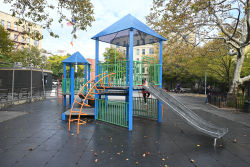Horseshoe Playground
Horseshoe Park
Almost since this U-shaped park was created in 1897 it has been commonly known as Horseshoe Park because of its unusual shape. The site of the park was spared from development because of its steep slope with East 165th Street being routed around this park.
The horseshoe dates back to ancient times, when horsemen from Europe and Asia padded their horses’ hooves with leather to prevent wear and injury to the horses. Iron horseshoes similar to those used today first appeared in the second century BC. It was also around this time that the Roman cavalry invented the game of horseshoe pitching, in which horseshoes are tossed at stakes driven into the ground. The occupation of a horseshoer, also called a farrier, was an important position in medieval towns and villages because of the importance of horses for labor and transportation. Farriers became synonymous with blacksmiths, and frequently incorporated knowledge of rudimentary veterinary medicine in their trade. Although the presence of the horseshoe in everyday life declined with the advent of the automobile, the game of horseshoe pitching remains a popular picnic pastime today. The horseshoe is also recognized as a token of good luck.
The park, bounded by East 165th Street, Hall Place, and Rogers Place, lies in the neighborhood of Longwood, which takes its name from Longwood Park, an estate built in the area by S.B. White in the 1870s. Although White’s estate was bounded by Longwood and Intervale Avenues between Westchester Avenues and Southern Boulevard, the surrounding neighborhood, including the land on which this park stands, also became known as Longwood. In 1935, granite terraced steps were constructed on the southern side of the park, connecting the two segments of East 165th Street on either side of this park.
Horseshoe Park is home to many London plane trees, a species known for its ability to survive in harsh urban environments, including dry soil and polluted air. A hybrid of the American sycamore and the Oriental plane tree, the London plane tree resembles the American sycamore, but its fruit clusters are borne in pairs rather than singly. The tree first appeared in London, England in 1645. Its ability to withstand air pollution, drought and other adversities assures its wide usage among in urban parks worldwide.
On the southern boundary of the park a flight of granite terraced steps align with lampposts. Game tables sit on the sidewalk along Hall Place. The park underwent a renovation in the winter of 1962-1963, when slides and a sandpit were installed and the number of benches was doubled. In 1998, the City funded further renovations, and handball courts and new play equipment with safety surfacing were added. In 2009, the fence ringing the park was replaced, enhancing the appearance and safety of the site. Enclosed within the wrought iron fence, the playground features a public restroom, modular play equipment with safety surfacing, benches, and swings.
Check out your park's Vital Signs
Clean & Safe
Green & Resilient
Empowered & Engaged Users
Share your feedback or learn more about how this park is part of a
Vital Park System







